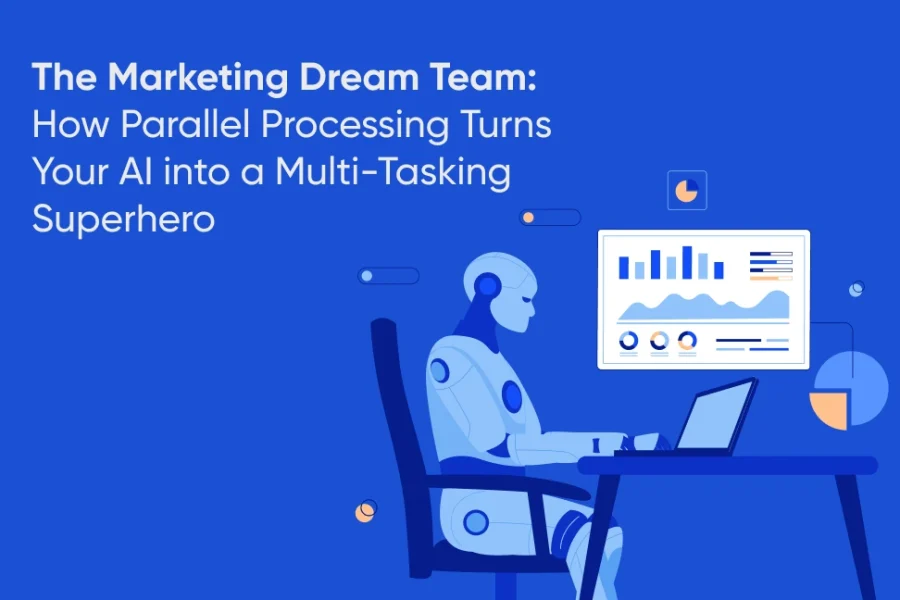Picture this scenario:
Your biggest client just called. They want to launch a new product across five channels in two weeks. While you’re still recovering from that phone call, your boss drops by with “just a quick request” they need competitive analysis, creative concepts, and budget projections by tomorrow morning for the board meeting.
In the old world, this meant one frantic all-nighter or disappointing someone important. But what if I told you there’s an architecture that makes your AI work like a perfectly coordinated pit crew, where multiple tasks happen simultaneously without chaos or compromise?
Welcome to parallel processing the architecture that transforms marketing AI from a helpful assistant into a multi-tasking superhero.
The Multi-Channel Reality Check
Before we dive into the solution, let’s acknowledge what you’re already dealing with
According to recent research, 73% of consumers prefer shopping through more than one channel, and 72% of consumers prefer connecting with brands through multiple channels. Meanwhile, 87% of retailers agree that a multi-channel strategy is critical to their success.
The pressure is real: your customers expect seamless experiences across every touchpoint, but your team is drowning in the complexity of managing them all.
Here’s where it gets interesting:
Multi-channel shoppers spend three times more than single-channel shoppers and companies with strong multi-channel marketing see a 9.5% increase in annual revenue.
The opportunity is massive, but most teams are stuck in sequential thinking when they need parallel execution.
What Parallel Processing Actually Means for Marketing
Think about the last Marvel movie you watched. Remember that epic battle scene where multiple heroes are fighting simultaneously across different fronts, each using their unique superpowers, but all working toward the same objective?
That’s parallel processing for marketing.
Instead of waiting for your copywriter to finish before your designer can start, or completing your Facebook ads before moving to Google Ads, parallel processing architecture deploys multiple AI agents simultaneously, each handling different aspects of your campaign while maintaining perfect coordination.
Here’s the magic: concurrent execution with intelligent coordination. Like having a dream team where everyone knows exactly what they’re supposed to do, when to do it, and how their work fits with everyone else’s—except this team never gets tired, never misses deadlines, and never has creative differences.
The “Sequential Bottleneck” Problem
Let’s be honest about what typically happens with complex marketing initiatives:
- Week 1: Strategy team develops campaign concept
- Week 2: Creative brief bounces between departments for “refinement”
- Week 3: Design team creates assets (while waiting for final copy)
- Week 4: Copy team writes content (while guessing at final design direction)
- Week 5: Media team plans placement (hoping creative will be ready)
- Week 6: Everyone scrambles to make everything work together
- Week 7: Launch (fingers crossed)
Sound painfully familiar?
Research shows that 58% of marketing leaders have automated email, 49% social media, and 33% content management, but they’re still thinking sequentially.
The tools are automated, but the workflow is still stuck in the assembly line era.
Meanwhile, 74% of marketers report that automation helps them save time by automating repetitive tasks, but parallel processing can compress entire campaign timelines by 60-70% while improving quality through real-time coordination.
How Parallel Processing Transforms Campaign Execution
Let’s reimagine that product launch scenario with parallel processing architecture:
-
Concurrent Creative Development
While AI Agent A analyzes your target audience and develops messaging frameworks, AI Agent B simultaneously researches competitor positioning and creates differentiation strategies. AI Agent C develops visual concepts based on brand guidelines and product specifications, while AI Agent D optimizes budget allocation across channels. All happening at the same time, with each agent sharing relevant insights in real-time.
-
Simultaneous Channel Optimization
Your Google Ads agent creates search campaigns while your Facebook agent develops social creative, your LinkedIn agent crafts B2B messaging, and your email agent builds nurture sequences. Each agent understands the overall strategy but executes channel-specific optimization simultaneously.
-
Real-Time Competitive Intelligence
Multiple agents monitor competitor activity across channels simultaneously—one tracking their pricing changes, another analyzing their ad copy evolution, while a third monitors their social media engagement patterns. All insights flow into your campaign optimization in real-time.
The result?
What used to take weeks of sequential handoffs now happens in days, with better coordination than human teams typically achieve.
The Business Case: Why CFOs Love Parallel Processing
Let’s talk numbers that matter to decision-makers.
Multi-channel marketing strategies can lead to a 20% increase in overall sales and 80% of marketers using multi-channel strategies say it improves brand awareness.
But here’s what makes parallel processing specifically compelling:
- Time Compression: Companies can save 6+ hours per week by automating social media posts and ads. Parallel processing extends this concept across all campaign elements, compressing launch timelines by 60-70%.
- Resource Optimization: eCommerce marketing automation can minimize manual tasks by 30%, but parallel processing maximizes the productivity of your existing team by eliminating workflow bottlenecks.
- Quality Through Speed: Instead of rushing at the end to meet deadlines, parallel processing allows each element to be optimized simultaneously, resulting in higher-quality campaigns delivered faster.
- Market Responsiveness: 65% of marketers plan to increase their investment in multi-channel marketing in 2024, but parallel processing allows you to respond to market opportunities in real-time rather than weeks.
Real-World Applications: Where Parallel Processing Excels
- Product Launch Campaigns: Simultaneously develop messaging, creative assets, channel strategies, and competitive positioning while coordinating everything for a cohesive launch.
- Crisis Response: When your brand faces a PR challenge, parallel agents can simultaneously monitor sentiment, develop response strategies, create content, and coordinate messaging across all channels.
- Seasonal Campaigns: Black Friday, holiday seasons, or industry events where timing is everything. Parallel processing allows you to execute comprehensive campaigns without compromising speed or quality.
- A/B Testing at Scale: Run multiple test variations across different channels simultaneously, with real-time optimization based on cross-channel insights.
- Competitive Response: When competitors launch new campaigns, parallel processing allows you to analyze, strategize, and counter across multiple channels faster than they can adapt.
When Parallel Processing Isn’t the Right Choice
Transparency matters, so let’s discuss when parallel processing might be overkill:
- Simple, Single-Channel Campaigns: If you’re just creating a LinkedIn post or sending a basic email, the coordination overhead isn’t worth it.
- Highly Iterative Creative Work: When your campaign depends on extensive creative exploration and artistic iteration, human creativity should lead the process.
- Limited Channel Strategy: If your business genuinely only needs 1-2 marketing channels, parallel processing won’t provide significant benefits.
- Resource-Constrained Organizations: Very small teams might benefit more from prompt chaining’s sequential approach before scaling to parallel execution.
Getting Started: Your First Parallel Campaign
Ready to test parallel processing? Start with your next multi-channel campaign:
- Map Your Campaign Elements: Identify which tasks can happen simultaneously (creative development, channel setup, competitive analysis)
- Define Coordination Points: Determine when agents need to share insights with each other
- Set Unified Objectives: Ensure all parallel agents understand the overarching campaign goals
- Choose Your Pilot: Start with a medium-complexity campaign where mistakes aren’t costly
- Measure Everything: Track time savings, quality improvements, and coordination effectiveness
The Competitive Reality You Can’t Ignore
Here’s what’s happening while you’re reading this:
41% of marketing decision makers have already significantly automated their customer journeys, and the early adopters of parallel processing are capturing market opportunities faster than ever.
The companies mastering parallel processing aren’t just launching campaigns faster, they’re responding to market changes, competitive threats, and customer needs with a speed that makes their competitors look static.
While your competitors debate whether to invest in marketing automation, the smartest teams are already implementing parallel processing to dominate market timing. In marketing, being first to market often matters more than having the biggest budget.
The Architecture Stack Revolution
We’ve covered the foundation (prompt chaining) and concurrent execution (parallel processing).
But what happens when you need a central intelligence coordinating multiple parallel teams?
In our Next Blog of this series: We’ll explore orchestrator-workers architecture imagine parallel processing with a brilliant conductor ensuring every agent works in perfect harmony toward strategic objectives.
Think of it as parallel processing with a strategic brain. Because while parallel processing solves the speed problem, orchestrator-workers architecture solves the strategic alignment problem. And in complex marketing environments, you need both speed and strategy.
Ready to implement parallel processing in your marketing operations?
Explore our Agentic AI services or calculate your potential time savings with our ROI calculator.
Need the foundation first?
Read 👉 The Marketing Assembly Line Revolution: Why Prompt Chaining Is Your Campaign’s New Best Friend to understand sequential AI workflows.


